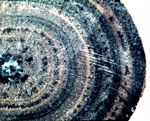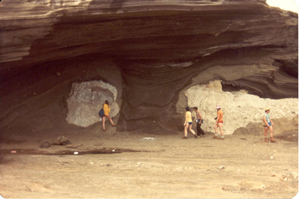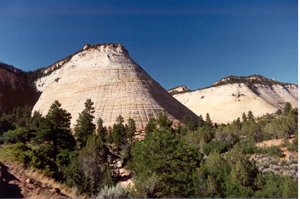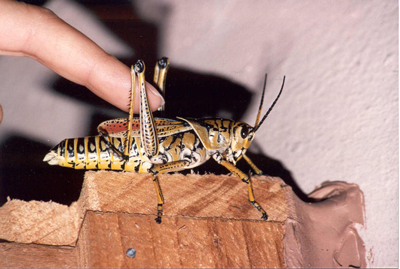
I am an igneous petrologist
DOLORES DURANT
PhD, University of Ottawa (2001), Ottawa, Ontario
MA, The Johns Hopkins University (1993), Baltimore, Maryland
MSc., McMaster University (1991), Hamilton, Ontario
BSc., McMaster University (1985), Hamilton, Ontario
I started picking up rocks along the beach as a child and still haven't stopped (the main reason why I own a truck!). My mother bought a rock tumbler, put our beach rocks through its eight-week cycle (a length of time close to eternity when you’re a kid!), and voila, marvellously shiny, colourful stones finally came out. We were hooked and eventually we joined the Gemini Gem and Mineral Club of Burlington when I was about 14 years old. This opened up a whole new world for me of beautiful crystals that came in so many colours, shapes and sizes. I was amazed that such perfect and varied structures could form naturally in the Earth and I wanted to understand everything about how the Earth works.
Today, I am an igneous petrologist
igneous petrologist
igneous petrologist
with a PhD in earth sciences
"The study of the earth. This science includes such disciplines as geology, geochemistry, geophysics, hydrogeology, geography, meteorology and looks at how they are all interrelated in order to more fully understand the nature of the entire earth."
from the University of Ottawa and have learned along the way, a great deal more about the Earth’s inner and outer workings. For my PhD, I studied orbicules
orbicules  "Round to oval, multi-shelled, igneous phenomena that can form in magma chambers, dikes and very occasionally, thick lava flows. They range from a few to 10’s of cm in diameter. The shells alternate light and dark reflecting the main minerals found there."
and comb layering
comb layering
"Same type of crystallization as found in the orbicules but laid out in horizontal layers that look like ribbons. Outcrops can be up to 10’s of m long and up to 10 m thick comprising of some 1000-cm thick layers."
that I collected from the foothills of the
Sierra Nevada Mountains
"."
in California; an area of white-rock mountains, deep green coniferous trees and small blue-black ponds that reflect the clear blue skies. The orbicules
"Round to oval, multi-shelled, igneous phenomena that can form in magma chambers, dikes and very occasionally, thick lava flows. They range from a few to 10’s of cm in diameter. The shells alternate light and dark reflecting the main minerals found there."
and comb layering
"Same type of crystallization as found in the orbicules but laid out in horizontal layers that look like ribbons. Outcrops can be up to 10’s of m long and up to 10 m thick comprising of some 1000-cm thick layers."
contain
elongated crystals
"Crystals that have"
that grew perpendicular to a round surface (orbicules) or to a horizontal surface (comb layering). The orbicules (~40-50 cm in diameter) contain up to 40 layers while the comb layering can be up to 10 metres thick encompassing up to a thousand centimetre-thick layers! In some of the orbicules, I found chemically
reversed-zoned,
"Opposite of normal zoning. When a crystal grows, it picks up the elements that are in the melt surrounding it. This usually occurs as the magma is cooling. Many experiments on the chemical components of magmas have shown that e.g. FeO is easier to crystallize as the temperature of a magma decreases than MgO. Thus when a crystal of say orthopyroxene grows, its initial composition at higher magmatic temperatures, will be richer in MgO while its final composition, at cooler magmatic temperatures, will be richer in FeO. This is normal zoning. Occasionally crystals can be found that have reverse zoning, i.e. early growth is FeO rich while their final growth is MgO rich. There are several possible mechanisms: composition of the magma changes through mixing with another magma; change in pressure by degassing of the magma by eruption; growth at constant temperature."
branching
orthopyroxene
"An iron and magnesium chain silicate with a chemical composition of approximately MgFeSiO2."
and plagioclase crystals with smoothly increasing amounts of Fe and Ca respectively along the lengths of the crystals. I used this information to hypothesize that the orbicules and comb layering formed at the far-from-equilibrium conditions that exist in a newly injected magma before it undergoes widespread, near-to-equilibrium, plutonic crystallization.
"Round to oval, multi-shelled, igneous phenomena that can form in magma chambers, dikes and very occasionally, thick lava flows. They range from a few to 10’s of cm in diameter. The shells alternate light and dark reflecting the main minerals found there."
and comb layering
comb layering
"Same type of crystallization as found in the orbicules but laid out in horizontal layers that look like ribbons. Outcrops can be up to 10’s of m long and up to 10 m thick comprising of some 1000-cm thick layers."
that I collected from the foothills of the
Sierra Nevada Mountains
"."
in California; an area of white-rock mountains, deep green coniferous trees and small blue-black ponds that reflect the clear blue skies. The orbicules
"Round to oval, multi-shelled, igneous phenomena that can form in magma chambers, dikes and very occasionally, thick lava flows. They range from a few to 10’s of cm in diameter. The shells alternate light and dark reflecting the main minerals found there."
and comb layering
"Same type of crystallization as found in the orbicules but laid out in horizontal layers that look like ribbons. Outcrops can be up to 10’s of m long and up to 10 m thick comprising of some 1000-cm thick layers."
contain
elongated crystals
"Crystals that have"
that grew perpendicular to a round surface (orbicules) or to a horizontal surface (comb layering). The orbicules (~40-50 cm in diameter) contain up to 40 layers while the comb layering can be up to 10 metres thick encompassing up to a thousand centimetre-thick layers! In some of the orbicules, I found chemically
reversed-zoned,
"Opposite of normal zoning. When a crystal grows, it picks up the elements that are in the melt surrounding it. This usually occurs as the magma is cooling. Many experiments on the chemical components of magmas have shown that e.g. FeO is easier to crystallize as the temperature of a magma decreases than MgO. Thus when a crystal of say orthopyroxene grows, its initial composition at higher magmatic temperatures, will be richer in MgO while its final composition, at cooler magmatic temperatures, will be richer in FeO. This is normal zoning. Occasionally crystals can be found that have reverse zoning, i.e. early growth is FeO rich while their final growth is MgO rich. There are several possible mechanisms: composition of the magma changes through mixing with another magma; change in pressure by degassing of the magma by eruption; growth at constant temperature."
branching
orthopyroxene
"An iron and magnesium chain silicate with a chemical composition of approximately MgFeSiO2."
and plagioclase crystals with smoothly increasing amounts of Fe and Ca respectively along the lengths of the crystals. I used this information to hypothesize that the orbicules and comb layering formed at the far-from-equilibrium conditions that exist in a newly injected magma before it undergoes widespread, near-to-equilibrium, plutonic crystallization.
 My MSc involved collecting dyke rocks from the Spanish Peaks Dyke Swarm in the Rocky Mountains of Colorado. There are hundreds of dykes here; vertical walls of rock up to 10 metres high and several kilometres in length that range in composition from black gabbro to white granodiorite. I measured the crystal size distributions of augite, plagioclase and magnetite in order to demonstrate the mathematical relationship between crystal growth rate, nucleation rate and temperature. My MSc involved collecting dyke rocks from the Spanish Peaks Dyke Swarm in the Rocky Mountains of Colorado. There are hundreds of dykes here; vertical walls of rock up to 10 metres high and several kilometres in length that range in composition from black gabbro to white granodiorite. I measured the crystal size distributions of augite, plagioclase and magnetite in order to demonstrate the mathematical relationship between crystal growth rate, nucleation rate and temperature.
During my M.A., I looked at nodules (~1 inch in diameter) that formed during in-situ vitrification tests at Oak Ridge National Laboratory. The tests consisted of mixing soil with limestone (50:50) in a pit and then melting the mixture to ~1500 C. The glass that forms after cooling was then chemically analysed. The process is one of the procedures under consideration for trapping toxic elements within contaminated soils. The nodules contain incredible dendritic crystals that curl in fanciful shapes that look like fans and peacock feathers. The crystals are composed of anorthite and wollastinite.
Huerfano Butte Colorado supplied the rocks for my B.Sc. thesis. This butte consists of a central ryholitic dike surrounded by an andesitic cone.
Throughout my undergraduate, I worked in geology during the summers; in the Triassic, red sandstone beds of the Bay of Fundy (with its 10 metre tides!), doing VLF (Very Low Frequency) surveys in Northern Ontario on old gold mine tailings piles, making maps for the oil patch in Calgary, and looking for anthracite coal in Northern British Columbia.
Throughout my graduate years, I was a teaching assistant for many courses and learned a great deal in interesting courses like Mathematical Modelling in Hydrogeology, Environmental Earth Systems, and, Habitats, Extinctions and Biodiversity. I taught third year Igneous Petrology at the University of Ottawa as a sabbatical replacement. Interacting with students is a joy and a challenge as they attempt to get the answer out of me and as I offer to help them find the answers for themselves (keeps the mind very active and alert!). I also spent three months teaching grade 10 physical science and grade 11 chemistry.
I’ve gone on many field trips and, being a geologist, I tend to take vacations in places where there are neat rocks.  I’ve climbed up the volcanoes in Montserrat, St. Vincent and Hawaii (melted the soles of my running shoes on a still hot aa lava flow!); climbed down the Ries craters in Germany and Barringer Crater, Arizona; got baked in the Grand Canyon, Bryce Canyon, Zion Canyon and the Painted Desert of Utah and Arizona as well as the Badlands of Alberta. I’ve climbed up the volcanoes in Montserrat, St. Vincent and Hawaii (melted the soles of my running shoes on a still hot aa lava flow!); climbed down the Ries craters in Germany and Barringer Crater, Arizona; got baked in the Grand Canyon, Bryce Canyon, Zion Canyon and the Painted Desert of Utah and Arizona as well as the Badlands of Alberta.
 I’ve snorkelled the reefs of the Caribbean and the Florida Panhandle; walked under natural stone arches in Utah, Arizona and Virginia; picked my way through hot springs at Yellowstone and Lassen, California; trod on the columnar basalts of Devil’s Tower South Dakota (of “Close Encounters of the Third Kind” fame) and Hawaii (had to learn how to hula!); sat on the huge logs of petrified wood in the Petrified Forest of Arizona; trod through caves in Luray, Virginia and Mesa Verde, Colorado. I’ve snorkelled the reefs of the Caribbean and the Florida Panhandle; walked under natural stone arches in Utah, Arizona and Virginia; picked my way through hot springs at Yellowstone and Lassen, California; trod on the columnar basalts of Devil’s Tower South Dakota (of “Close Encounters of the Third Kind” fame) and Hawaii (had to learn how to hula!); sat on the huge logs of petrified wood in the Petrified Forest of Arizona; trod through caves in Luray, Virginia and Mesa Verde, Colorado.  Travelling to these spots is not only awe inspiring but has also often allowed me to educate people on the wonders of the earth - explaining concepts like plate tectonics or clearing up confusion over the greenhouse effect. Travelling to these spots is not only awe inspiring but has also often allowed me to educate people on the wonders of the earth - explaining concepts like plate tectonics or clearing up confusion over the greenhouse effect.
I’ve taken pictures of black bears in the Smoky Mountains of Tennessee and grizzlies in the Coastal Ranges of British Columbia; alligators in Florida and Georgia; 6 inch long red and yellow grasshoppers in Florida (had to ask what they were since I come from the land of 1 inch brown grasshoppers!);  chipmunks sitting on my leg at Moraine Lake, Alberta. I’ve be bitten by black flies, yellow flies, deer flies, horse flies (they sound like helicopters they’re so big!), and more mosquitoes than I can count. chipmunks sitting on my leg at Moraine Lake, Alberta. I’ve be bitten by black flies, yellow flies, deer flies, horse flies (they sound like helicopters they’re so big!), and more mosquitoes than I can count.
Currently, I’m working at Natural Resources Canada’s Centre for Remote Sensing as a scientist for the GeoConnections Discovery Portal. This is a web site that contains metadata (data about data) for the Canadian Geospatial Data Infrastructure. It’s a recent initiative by the Canadian federal and provincial governments along with private interests to make Canadian geospatial digital data available to all Canadians (and the rest of the world) on the internet. My job includes working with government departments to help enhance the Infrastructure with new technologies like web mapping services and web feature services to give Canadians the power to create their own maps using the latest satellite images and geoscientific information. I get to travel from coast to coast to show new technologies, to see new software applications and to interact with people who have an intense desire to share their data with the world so that everyone (not just scientists or politicians!) can become more knowledgeable about the world around them and thus to be able to make informed decisions regarding such issues as the environment, integrated coastal management, climate change, etc.
My studies continue. I play classical guitar (I have my grade 5) and am learning to play the piano. Also there is always something new and exciting happening in science. I like to read most everything I can get my hands on whether it be physics, chemistry, astronomy, mathematics, science fiction or the daily newspaper. I also fit in occasionally some of the great literary classics such as Beowulf and Dante’s Divine Comedy Trilogy. When I was deciding about whether or not to go to graduate school, one thing that made me hesitate was my perception that doing a thesis would narrow my understanding of science, that I would have to pick some narrow, specialized topic that would restrict my view of the world. I couldn’t have been more wrong. Doing my theses has taken me to places that I would never have gone to, both literally and figuratively; new places to visit in the world, new aspects of sciences that I had never known of, and meeting of people who could help me understand new and interesting concepts that have opened my eyes in ways that books and television could never do.
|